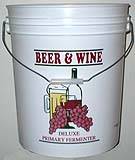Fermentation takes around two weeks to complete, and could take significantly longer depending on what style of beer you are making. The wort (unfinished beer) stays in the primary fermenter or carboy for this amount of time. It’s important that you choose the right primary fermenter or carboy, as your wort will be stored there for almost the entire process.
I received a comment this morning on the “Beginners Home Brewing Kit” article that was posted on September 20th. It brought up some important questions about Primary Fermenters and Carboy options for home brewing that I want to share. Here is the comment:
My original post was about a beginners home brewing kit that came with an “Ale Pail” as the primary fermenter. Although it looks like a large paint bucket that you may get at a home improvement store, the plastic it is made from is completely different. Ale pails are made with food grade plastic, otherwise known as PET (Polyethylene Terephthalate). PET wont leach into your beer over the two weeks it’s stored there, and you could have this problem with a basic paint bucket. They’re not expensive, so they’re definitely a worthwhile investment. There are also plastic carboys that are clear that do a pretty good job. The advantages of a clear plastic carboy is that you can see whats going on at all times, just make sure to not expose your wort to direct sunlight. I’ll be doing an article on glass carboys in the future also. Here are some of the plastic options out there:
I’ve NEVER had an issue with mold, but that is probably unrelated to the type of plastic being used. Mold can be caused when the bucket isn’t 100% sanitized. Scratches and gouges can create creases that your sanitizer may not be able to penetrate. Fermenters are stored at room temperature and have a lot of trapped moisture, which makes it an environment conducive for mold if not sanitized properly.
If you are using any kind of plastic fermenter in your home brewing kit, thoroughly inspect your pail before transferring your wort. I look for any scratches or gouges thicker than my fingernail. A common mistake is using an abrasive pad or abrasive brush when cleaning the bucket. The plastic itself is not very rigid, and anything abrasive can end up scratching the surface making it more susceptible to contamination. It’s also not a good idea to store anything in the buckets between batches (especially nothing metal like stirring spoons or cans of Liquid Malt Extract).
As long as your ale pail is sanitized and sealed shut, there is no possibility for mold. I’m going to do some follow-up posts on proper sanitizing procedures as this is often neglected step that can lead to some frustration. Feel free to check out some of the beginner home brewing kits if you’re new to home brewing and you’re looking for a good place to start.
Have fun choosing your next primary fermenter – Cheers!






One Response to Plastic Primary Fermenter Options for Home Brewing